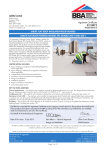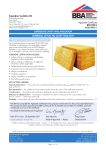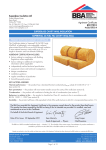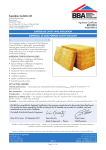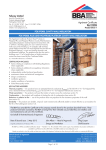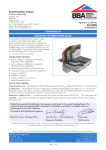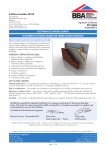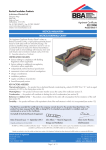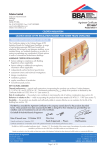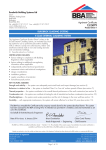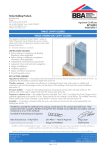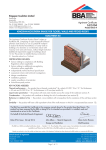Download BBA certificate
Transcript
APPROVAL INSPECTION TESTING CERTIFICATION Jablite Limited Infinity House Anderson Way Belvedere Kent DA17 6BG TECHNICAL APPROVALS FOR CONSTRUCTION Agrément Certificate 96/3215 Tel: 020 8320 9100 Fax: 020 8320 9110 Product Sheet 1 website: www.jablite.co.uk JABLITE FULL FILL CAVITY WALL INSULATION JABFILL PREMIUM This Agrément Certificate Product Sheet(1) relates to Jabfill Premium, an expanded polystyrene board for use as thermal insulation in new, external masonry cavity walls up to 12 m in height in domestic and non-domestic buildings. (1) Hereinafter referred to as ‘Certificate’. CERTIFICATION INCLUDES: • factors relating to compliance with Building Regulations where applicable • factors relating to additional non-regulatory information where applicable • independently verified technical specification • assessment criteria and technical investigations • design considerations • installation guidance • regular surveillance of production • formal three-yearly review. KEY FACTORS ASSESSED Thermal performance — the product has a thermal conductivity (l90/90 value) of 0.032 W·m–1·K–1 (see section 6). Rain penetration — the product will resist water transfer across the cavity and may be used in any exposure zone in suitably constructed walls (see sections 4 and 7). Condensation — the product will contribute to limiting the risk of condensation (see section 8). Behaviour in relation to fire — The boards are classified as Class E reaction-to-fire in accordance with BS EN 13501-1 : 2007 and contain a flame-retardant additive. The product is classified as ‘combustible’ but can be used in suitably designed walls (see section 9). Durability — the product will have a life equivalent to that of the wall structure in which it is incorporated (see section 12). The BBA has awarded this Certificate to the company named above for the product described herein. This product has been assessed by the BBA as being fit for its intended use provided it is installed, used and maintained as set out in this Certificate. On behalf of the British Board of Agrément Date of Fourth issue: 15 July 2013 John Albon — Head of Approvals Claire Curtis-Thomas Originally certificated on 15 March 1996 Energy and Ventilation Chief Executive The BBA is a UKAS accredited certification body — Number 113. The schedule of the current scope of accreditation for product certification is available in pdf format via the UKAS link on the BBA website at www.bbacerts.co.uk Readers are advised to check the validity and latest issue number of this Agrément Certificate by either referring to the BBA website or contacting the BBA direct. British Board of Agrément Bucknalls Lane Watford Herts WD25 9BA ©2013 Page 1 of 12 tel: 01923 665300 fax: 01923 665301 e-mail: [email protected] website: www.bbacerts.co.uk Regulations In the opinion of the BBA, Jabfill Premium, if installed, used and maintained in accordance with this Certificate, will meet or contribute to meeting the relevant requirements of the following Building Regulations (the presence of a UK map indicates that the subject is related to the Building Regulations in the region or regions of the UK depicted): The Building Regulations 2010 (England and Wales) (as amended) Requirement: C2(a) Resistance to moisture Comment: The product does not absorb water by capillary action and therefore may be used in situations where it bridges the damp-proof course (dpc) of the inner or outer leaf. See section 7.1 of this Certificate. Requirement: C2(b) Resistance to moisture Comment: Tests by the BBA indicate that a wall incorporating this product can resist rain penetration and satisfy this Requirement. See sections 4.2 and 4.5 of this Certificate. Requirement: C2(c) Resistance to moisture Comment: Requirement: L1(a)(i) The product can contribute to satisfying this Requirement. See sections 8.1 and 8.3 of this Certificate. Comment: Regulation: 7 The product can contribute to meeting this Requirement. See sections 6.1 and 6.2 of this Certificate. Comment: Regulation: 26 The product is acceptable. See section 12 and the Installation part of this Certificate. Comment: The product can contribute to meeting this Regulation. See sections 6.1 and 6.2 of this Certificate. Conservation of fuel and power Materials and workmanship CO2 emission rates for new buildings The Building (Scotland) Regulations 2004 (as amended) Regulation: 8(1) Fitness and durability of materials and workmanship Comment: The product can contribute to a construction satisfying this Regulation. See section 12 and the Installation part of this Certificate. Regulation: Standard: Building standards applicable to construction Moisture from the ground 9 3.4 Comment: Standard: 3.10 Comment: Standard: 3.15 The product does not absorb water by capillary action and therefore may be used where it bridges the dpc of the inner or outer leaf, with reference to clause 3.4.1(1)(2). See section 7.1 of this Certificate. Precipitation Walls incorporating the product can satisfy this Standard, with reference to clauses 3.10.1(1)(2) and 3.10.3(1)(2) and 3.4.5(1)(2. See sections 4.2 and 4.5 of this Certificate. Condensation Comment: The product can contribute to satisfying this Standard, with reference to clauses 3.15.1(1)(2), 3.15.4(1)(2) and 3.15.5(1)(2). See sections 8.2 and 8.3 of this Certificate. Standard: Standard: Carbon dioxide emissions Building insulation envelope 6.1(b) 6.2 Comment: Standard: 7.1(a)(b) Comment: Regulation: 12 The product can contribute to satisfying clauses, or parts of clauses, 6.1.1(1), 6.1.2(2), 6.1.6(1), 6.2.1(1)(2), 6.2.3(1), 6.2.4(2), 6.2.5(2), 6.2.9(1), 6.2.11(2), 6.2.11(1) and 6.2.13(2). See sections 6.1 and 6.2 of this Certificate. Statement of sustainability The product can contribute to meeting the relevant requirements of Regulation 9, Standards 1 to 6, and therefore will contribute to a construction meeting a bronze level of sustainability as defined in this Standard. In addition, the product can contribute to a construction meeting a higher level of sustainability as defined in this Standard, with reference to clauses 7.1.4(1)(2) [Aspects 1(1)(2) and 2(1)], 7.1.6(1)(2) [Aspects 1(1)(2) and 2(1)] and 7.1.7(1)(2) [Aspect 1(1)(2)]. See section 6 of this Certificate. Building standards applicable to conversions Comment: All comments given for these systems under Regulation 9, also apply to this Regulation, with reference to clause 0.12.1(1)(2) and Schedule 6(1)(2). (1) Technical Handbook (Domestic). (2) Technical Handbook (Non-Domestic). The Building Regulations (Northern Ireland) 2012 Regulation: 23 Fitness of materials and workmanship Comment: Regulation: 28(a) The product is acceptable. See section 12 and the Installation part of this Certificate. Comment: The product does not absorb water by capillary action and therefore may be used where it bridges the dpc of the inner or outer leaf. See section 7.1 of this Certificate. Regulation: 28(b) Resistance to moisture and weather Resistance to moisture and weather Comment: Regulation: 29 Walls incorporating the product can satisfy this Regulation. See sections 4.2 and 4.5 of this Certificate. Comment: The product can contribute to satisfying this Regulation. See section 8.3 of this Certificate. Condensation Page 2 of 12 Regulation: 39(a)(i) Conservation measures Comment: Regulation: The product can satisfy or contribute to satisfying this Regulation. See sections 6.1 and 6.2 of this Certificate. 40(2) Target carbon dioxide emission rate Comment: The product can contribute to a building satisfying its target emission rate. See sections 6.1 and 6.2 of this Certificate. Construction (Design and Management) Regulations 2007 Construction (Design and Management) Regulations (Northern Ireland) 2007 In the opinion of the BBA, there is no information in this Certificate which relates to the obligations of the client, CDM co-ordinator, designer and contractors under these Regulations. Additional Information NHBC Standards 2013 NHBC accepts the use of Jabfill Premium, other than in very severe exposure locations with fair-faced masonry, provided it is installed, used and maintained in accordance with this Certificate, in relation to NHBC Standards, Chapter 6.1 External masonry walls. Technical Specification 1 Description 1.1 Jabfill Premium comprises a grey EPS 70 expanded polystyrene board which complies with BS EN 13163 : 2012 and has a class E reaction to fire classification to BS EN 13501-1 : 2007. 1.2 The boards have the nominal characteristics of: • size (mm) 1200 by 450 • thickness(1) (mm) 75, 100, 125 and 150. (1) Includes projecting flutes (see Figure 2). 1.3 Each board incorporates a specially designed tongue-and-groove edging on all four edges, enabling the boards to interlock when installed. 1.4 The external face of the board incorporates tapered flutes to provide a drainage plane and shed water away from the internal leaf and act as a guide to the construction of the outer leaf. Each board is marked to identify the correct orientation for installation (see Figures 1 and 2). Figure 1 Jabfill Premium panel (all dimensions in mm) 1196 15 325 this way up external face 225 50 275 100 442 446 Jabfill Premium 44 30 BBA 96/3215 46 11 CFC and HCFC free 1200 Page 3 of 12 35 19 Figure 2 Jabfill Premium panel — side elevation (all dimensions in mm) 44 2 10 2 2 15 13 30 25 30.5 14 10.5 15 14 446 5 75 mm and 100 mm board size 19 11 with 5 dia nose 2 Manufacture 2.1 Jabfill Premium is manufactured from carbon-enriched EPS (expanded polystyrene). The material comprises expandable beads of polystyrene pre-foamed and fused together in a steam-heated shape mould under pressure. 2.2 As part of the assessment and ongoing surveillance of product quality, the BBA has: • agreed with the manufacturer the quality control procedures and product testing to be undertaken • assessed and agreed the quality control operated over batches of incoming materials • monitored the production process and verified that it is in accordance with the documented process • evaluated the process for management of nonconformities • checked that equipment has been properly tested and calibrated • undertaken to carry out the above measures on a regular basis through a surveillance process, to verify that the specifications and quality control operated by the manufacturer are being maintained. 2.3 The management system of Jablite Limited has been assessed and registered as meeting the requirements of BS EN ISO 9001 : 2008 and BS EN ISO 14001 : 2004 by British Standards Institute (Certificates FM/01260 and EMS/559414 respectively). 3 Delivery and site handling 3.1 The boards are delivered to site in packs wrapped in polythene. Each pack contains a label bearing the manufacturer’s trade name and the BBA logo incorporating the number of this Certificate. 3.2 The product should be protected from prolonged exposure to sunlight and should be stored either under cover or protected with opaque polythene. Care should be taken to avoid contact with solvents and with materials containing volatile organic components. 3.3 The boards must be stored flat, protected from high winds and raised above damp surfaces. 3.4 The boards must not be exposed to open flame or other ignition sources. 3.5 Care should be taken when handling boards; damaged or contaminated boards should be discarded. Page 4 of 12 Assessment and Technical Investigations The following is a summary of the assessment and technical investigations carried out on Jabfill Premium. Design Considerations 4 Use 4.1 Jabfill Premium is effective in reducing the U value (thermal transmittance) of cavity walls with masonry inner and outer leaves, where masonry includes clay and calcium silicates bricks, concrete blocks and natural and reconstituted stone blocks, in new buildings up to 12 m in height. 4.2 New buildings subject to national Building Regulations and Standards should be suitable when assessed in accordance with the relevant recommendations of: • BS EN 1996-1-1 : 2005, BS EN 1996-1-2 : 2005, 1996-2 : 2006 and BS EN 1996-3 : 2006 • BS 8000-3 : 2001. 4.3 Other new buildings not subjected to any of the above should also be built in accordance with BS EN 1996-2 : 2006 and BS 8000-3 : 2001. 4.4 As with any other form of cavity wall insulation, where buildings need to comply with NHBC Standards 2013, specifiers should observe the requirements of these Standards. 4 .5 The product is for use in any exposure zone. However, the use of the product does not preclude the need to apply an external render coat or other suitable finish in severe exposure zones where such application would be normal practice. 4.6 To reduce the risk of water penetration, raked or recessed mortar joints should be avoided in severe or very severe exposure zones. 4.7 The use of cavity battens and/or boards is strongly recommended to prevent bridging by mortar droppings. 4.8 Care must be taken in the overall design and construction of walls incorporating the product to ensure the provision of appropriate: • cavity trays and dpcs • cavity barriers and fire dampers • resistance to the ingress of precipitation, moisture and dangerous gases from the ground • resistance to sound transmission when flanking separating walls and floors. 5 Practicability of installation The product should only be installed by a competent general builder, or a contractor, experienced with this type of product. 6 Thermal performance 6.1 Calculations of the thermal transmittance (U value) should be carried out in accordance with BS EN ISO 6946 : 2007 and BRE Report (BR 443 : 2006) Conventions for U-value calculations, using the declared thermal conductivity (l90/90 value) of 0.032 W·m–1·K–1. The value of a completed wall will depend on the insulation thickness, number and type of fixings, the insulating value of the substrate masonry and its internal finish. When considering insulation requirements, designers should refer to the detailed guidance contained in the documents supporting the national Building Regulations. The U values shown in Table 1 indicate that the product can contribute to a wall achieving typical U values referred to in those supporting documents Table 1 Achieving target U values using Jabfill Premium full fill cavity insulation (1) Target U value (W·m–2·K–1) Jabfill Premium — insulation thickness (mm) Inner leaf AAC block(2) with plasterboard on dabs internal finish Inner leaf block(3) with plaster internal finish 0.19 150 — 0.22 125 150 0.25 100 125 0.26 100 125 0.27 100 125 0.28 100 125 0.30 75 100 (1) Assume 102 mm thick brick outer leaf and 2.5 fully penetrating steel wall ties per m2 with cross sectional area of 12.5 mm2. (2) 100 mm AAC blockwork inner leaf (density 300 kg·m–3) with plasterboard on dabs internal finish (thermal conductivity 0.12 W·m–1·K–1). (3) 100 mm blockwork inner leaf (density 1800 kg·m–3) with 13 mm plaster internal finish (thermal conductivity 1.30 W·m–1·K–1). Page 5 of 12 6.2 The product can contribute to maintaining continuity of thermal insulation at junctions between elements and openings. For Accredited Construction Details the corresponding psi values in BRE Information Paper IP 1/06 Assessing the effects of thermal bridging at junctions and around openings, Table 3, may be used in carbon emission calculations in Scotland and Northern Ireland. Detailed guidance for other junctions and on limiting heat loss by air infiltration can be found in: England and Wales — Approved Documents to Part L, and for new thermal elements to existing buildings, Accredited Construction Details (version 1.0). For new-build, see also SAP 2009, Appendix K, and the iSBEM User Manual Scotland — Accredited Construction Details (Scotland) Northern Ireland — Accredited Construction Details (version 1.0). 7 Rain penetration 7.1 Tests by the BBA demonstrate that when the product is used in situations where it bridges the dpc in walls, dampness from the ground will not pass through to the inner leaf provided the wall is detailed in accordance with the requirements and provisions of the national Building Regulations. 7.2 Constructions built in accordance with BS EN 1996-2 : 2006, PD 6697 : 2010 and BS 5628-3 : 2005, will prevent water reaching the inner leaf in damaging amounts. Water penetrating the outer leaf of the wall will drain down the cavity face of the outer leaf. 7.3 In all situations it is important to ensure that: • installation is carried out to the highest level on each wall or the top edge of the insulation is protected by a cavity tray • wall ties are installed correctly and are thoroughly clean • excess mortar is cleaned from the cavity face of the leading leaf • mortar droppings are cleaned from the exposed edges of installed boards. 7.4 Window and door opening reveals are to be constructed incorporating a cavity barrier/closer/dpc as required (see sections 14 and 15). 7.5 Wall corners are to be constructed incorporating a vertical dpc, as noted in section 15.12 8 Condensation Surface condensation 8.1 Walls will limit the risk of surface condensation adequately when the thermal transmittance (U value) does not exceed 0.7 W·m–2·K–1 at any point, and the junctions with floors, roofs and openings are designed in accordance with Limiting thermal bridging and air leakage : Robust construction details for dwellings and similar buildings TSO 2002 or BRE Information Paper IP 1/06. 8.2 For buildings in Scotland, constructions will be acceptable where the thermal transmittance (U value) of the wall does not exceed 1.2 W·m–2·K–1 at any point and openings and junctions with other elements comply with the guidance given in BS 5250 : 2011, Annex G. Additional guidance can be found in BRE Report (BR 262 : 2002) Thermal insulation: avoiding risks. Interstitial condensation 8.3 Walls will limit the risk of interstitial condensation adequately when they are designed and constructed in accordance with BS 5250 : 2011, Annexes D and G. 8.4 The product has a nominal vapour resistivity exceeding 145 MN·s·g–1·m–1 and therefore will provide a significant resistance to water vapour transmission. 8.5 If the product is to be used in the external wall of rooms expected to have high humidity, care must be taken to provide adequate permanent ventilation to avoid possible problems from the formation of interstitial condensation in the internal wall leaf. 9 Behaviour in relation to fire 9.1 The product is classified as ‘combustible’. It contains a flame-retardant additive and has a Class E reaction-to-fire classification in accordance with BS EN 13501-1 : 2007. 9.2 Details of parts of a wall construction where cavity barriers can be omitted can be found in the following supporting documents: England and Wales — Approved Document B, Volume 1, Diagram 13, and Volume 2, Diagram 34 Scotland — Mandatory Standard 2.4 clauses 2.4.1(1)(2), 2.4.2(1)(2), 2.4.7(1) and 2.4.9(2). (1) Technical Handbook (Domestic). (2) Technical Handbook (Non-Domestic). Northern Ireland — Technical Booklet E, Diagram 4.5. Page 6 of 12 9.3 For constructions not covered by section 9.2, cavity barriers must be provided to comply with: England and Wales — Approved Document B, Volume 1, Section 6, and Volume 2, Section 9 Scotland — Mandatory Standard 2.4, clauses 2.4.1(1)(2), 2.4.2(1)(2), 2.4.7(1) and 2.4.9(2). (1) Technical Handbook (Domestic). (2) Technical Handbook (Non-Domestic). Northern Ireland — Technical Booklet E, Paragraphs 4.36 to 4.42. 9.4 The product is combustible but is unrestricted in walls with two leaves of masonry/concrete at least 75 mm thick, with cavity barriers around all openings and at the top of the wall in accordance with The Building (Scotland) Regulations 2004 (as amended) — Mandatory Standard 2.6, clauses 2.6.5(1) and 2.6.6(2). (1) Technical Handbook (Domestic). (2) Technical Handbook (Non-Domestic). 10 Proximity of flues and appliances When installing the product in close proximity to certain flue pipes and/or heat producing appliances, the relevant provisions of the national Building Regulations are applicable: England and Wales — Approved Document J Scotland — Mandatory Standard 3.19, clauses 3.19.1(1)(2) to 3.19.4(1)(2) and 3.19.8(1)(2). (1) Technical Handbook (Domestic). (2) Technical Handbook (Non-Domestic). Northern Ireland — Technical Booklet L. 11 Maintenance As the product is confined within the wall cavity and has suitable durability (see section 12), maintenance is not required. 12 Durability The product is durable, rot-proof, water resistant and sufficiently stable to remain effective as an insulant for the life of the building. 13 Reuse and recyclability Jablite EPS is fully recyclable and the company operates an environmental programme, recycling all in-house manufacturing waste as well as recycling packaging and other waste EPS from external sources. Installation 14 General 14.1 To comply with this Certificate, the Certificate holder’s representatives, on request, will attend the site to provide demonstrations to ensure correct installation from the outset. 14.2 Adequate supervision of the installation shall be maintained and the Certificate holder’s representatives should have right of access to site to ensure correct installation. 14.3 The internal leaf is constructed ahead of the external leaf. Any mortar protruding into the cavity space from the back of the internal leaf shall be cleaned off before installing the product. 14.4 Where required, door and window reveals should incorporate a cavity barrier/closer (see Figure 3). It is recommended that BBA-approved cavity barriers/closers are used. 14.5 Additional wall ties at 300 mm vertical centres within 225 mm of all openings are recommended in BS EN 1996-2 : 2006. For this product, this would involve piercing the boards and may introduce an unacceptable risk of water penetration. Therefore, it is recommended that an additional wall tie is included within 225 mm of the opening on each board course level to satisfy the structural requirements of the wall (see Figure 3). Page 7 of 12 Figure 3 Reveal detail with double ties 14.6 Double-triangle wall ties, without drips, but otherwise conforming to BS EN 845-1 : 2003, are suitable for use with this product. Other ties approved by the Certificate holder may also be suitable. 14.7 Wall corners must be constructed in accordance with section 15.12 and must incorporate a vertical dpc as shown in figure 6. 15 Procedure 15.1 Walls are constructed in the conventional manner, with the first row of wall ties where the insulation is to begin, but not on the dpc, and at approximately 600 mm horizontal spacing. The first run of boards may commence below dpc level to provide some edge insulation for the floor (see Figure 4). 15.2 A section of the wall leaf is built up to a course above the next row of wall ties which are placed at the usual spacing of 450 mm vertically and not more than 900 mm horizontally (see BS EN 1996-2 : 2006). 15.3 The boards are placed between the upper and lower wall ties to form a closely butt-jointed run. It is essential that all wall ties slope downwards towards the outer leaf. 15.4 The boards incorporate a specially designed tongue-and-groove edging and are faced on one side with projecting tapered flutes. For this design to function correctly it is essential that the boards are positioned with the horizontal tongued edge uppermost and the fluted face against the outer leaf. 15.5 The tongued edge is cut with a sharp knife or fine-tooth saw to allow insertion of the double-triangle wall ties. Care must be taken to ensure that only minimal damage is incurred during this process. 15.6 The other leaf is built up to the same level as the boards, with its inner face in contact with the boards. 15.7 Successive sections of wall, incorporating wall ties, are constructed and the boards installed as work proceeds up to the required height. Page 8 of 12 Figure 4 Reveal detail with double ties first run commences below dpc level to provide a minimum 150 mm depth insulation below the top of the floor insulation to the floor 15.8 After each section of the wall leaf is built, excess mortar should be removed and mortar droppings cleaned from exposed edges of the installed board before installation of the next section. Use of a cavity board is recommended to protect board edges and make cleaning easier (see Figure 5). Figure 5 Use of cavity board when cleaning off excess mortar 15.9 Using a fine-tooth saw, boards can be cut to fit around windows, doors and air bricks. It is essential that they are cut accurately so they completely fill the spaces for which they are intended and that no gaps are left in the insulation. 15.10 Where openings such as doors and windows are in close proximity, it is recommended that a continuous lintel is used. Damp-proofing at lintel level must be provided with stop ends and weepholes. 15.11 It must be ensured that proprietary cavity barriers/closers are correctly installed at window and door reveals as illustrated previously in Figure 3. 15.12 Corner details are formed by interlocking the boards. It is important that they are closely butt-jointed and, therefore, the tongue should be carefully removed where necessary so that all interfaces are uninterrupted. The tapered flutes are removed at internal corners only. All corner details incorporate a vertical dpc with a 150 mm overlap beyond the board ends (at all courses) as shown in Figure 6. Page 9 of 12 internal corner 150 Figure 6 Corner details (all dimensions in mm) internal blockwork 150 damp-proof course Jabfill Premium 150 damp-proof course 150 external corner external brickwork 15.13 The boards should always be installed to the highest level of each wall. 15.14 If installation of boards is terminated at any other levels, the top edge of the insulation must be protected by a cavity tray and alternate perpend joints raked out to provide adequate drainage of water from this tray. Protection 15.15 All building involving the product, particularly interrupted work, must conform to BS EN 1996-2 : 2006, Sections 3.2 Acceptance, handling and storage of materials and 3.6 Curing and protective procedures during execution. Technical Investigations 16 Tests Tests were carried out to determine: • density • dimensional accuracy. 17 Investigations 17.1 The manufacturing process was examined, including the methods adopted for quality control, and details were obtained of the quality and composition of the materials used. 17.2 An examination was made of data relating to: • water resistance of a cavity wall with the boards • compressive strength • cross-breaking strength • dimensional stability • water vapour permeability • behaviour in fire. 17.3 An assessment of the thermal and hygrothermal properties of the product was made including U value and condensation risk calculations for typical constructions. Page 10 of 12 Bibliography BS 5250 : 2011 Code of practice for control of condensation in buildings BS 5628-3 : 2005 Code of practice for the use of masonry — Materials and components, design and workmanship BS 8000-3 : 2001 Workmanship on building sites — Code of practice for masonry BS EN 845-1 : 2003 Specification for ancillary components for masonry — Ties, tension straps, hangers and brackets BS EN 1996-1-1 : 2005 Eurocode 6 : Design of masonry structures — General rules for reinforced and unreinforced masonry structures BS EN 1996-1-2 : 2005 Eurocode 6 : Design of masonry structures — General rules — Structural fire design BS EN 1996-2 : 2006 Eurocode 6 : Design of masonry structures — Design considerations, selection of materials and execution of masonry BS EN 1996-3 : 2006 Eurocode 6 : Design of masonry structures : Simplified calculation methods for unreinforced masonry structures BS EN 13163 : 2012 Thermal insulation products for buildings — Factory made products of expanded polystyrene (EPS) — Specification BS EN 13501-1 : 2007 Fire classification of construction products and building elements — Classification using test data from reaction to fire tests BS EN ISO 6946 : 2007 Building components and building elements — Thermal resistance and thermal transmittance — Calculation method BS EN ISO 9001 : 2008 Quality management systems — Requirements BS EN ISO 14001 : 2004 Environmental management systems — Requirements with guidance for use PD 6697 : 2010 Recommendations for the design of masonry structures to BS EN 1996-1-1 and BS EN 1996-2 Page 11 of 12 Conditions of Certification 18 Conditions 18.1 This Certificate: • relates only to the product/system that is named and described on the front page • is issued only to the company, firm, organisation or person named on the front page — no other company, firm, organisation or person may hold or claim that this Certificate has been issued to them • is valid only within the UK • has to be read, considered and used as a whole document — it may be misleading and will be incomplete to be selective; • is copyright of the BBA • is subject to English Law. 18.2 Publications, documents, specifications, legislation, regulations, standards and the like referenced in this Certificate are those that were current and/or deemed relevant by the BBA at the date of issue or reissue of this Certificate. 18.3 This Certificate will remain valid for an unlimited period provided that the product/system and its manufacture and/or fabrication, including all related and relevant parts and processes thereof: • are maintained at or above the levels which have been assessed and found to be satisfactory by the BBA • continue to be checked as and when deemed appropriate by the BBA under arrangements that it will determine • are reviewed by the BBA as and when it considers appropriate. 18.4 The BBA has used due skill, care and diligence in preparing this Certificate, but no warranty is provided. 18.5 In issuing this Certificate, the BBA is not responsible and is excluded from any liability to any company, firm, organisation or person, for any matters arising directly or indirectly from: • the presence or absence of any patent, intellectual property or similar rights subsisting in the product/system or any other product/system • the right of the Certificate holder to manufacture, supply, install, maintain or market the product/system • actual installations of the product/system, including their nature, design, methods, performance, workmanship and maintenance; • any works and constructions in which the product/system is installed, including their nature, design, methods, performance, workmanship and maintenance • any loss or damage, including personal injury, howsoever caused by the product/system, including its manufacture, supply, installation, use, maintenance and removal. • any claims by the manufacturer relating to CE marking. 18.6 Any information relating to the manufacture, supply, installation, use, maintenance and removal of this product/ system which is contained or referred to in this Certificate is the minimum required to be met when the product/system is manufactured, supplied, installed, used, maintained and removed. It does not purport in any way to restate the requirements of the Health and Safety at Work etc. Act 1974, or of any other statutory, common law or other duty which may exist at the date of issue or reissue of this Certificate; nor is conformity with such information to be taken as satisfying the requirements of the 1974 Act or of any statutory, common law or other duty of care. British Board of Agrément Bucknalls Lane Watford Herts WD25 9BA ©2013 Page 12 of 12 tel: 01923 665300 fax: 01923 665301 e-mail: [email protected] website: www.bbacerts.co.uk












